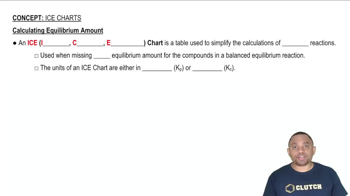Consider the reaction: SO2Cl2(g) ⇌ SO2(g) + Cl2(g) Kc = 2.99⨉10-7 at 227 °C If a reaction mixture initially contains 0.175 M SO2Cl2, what is the equilibrium concentration of Cl2 at 227 °C?
Consider the reaction: A(g) ⇌ 2B(g). Find the equilibrium partial pressures of A and B for each value of Kp. Assume that the initial partial pressure of B in each case is 1.0 atm and that the initial partial pressure of A is 0.0 atm. Make any appropriate simplifying assumptions. a. Kp = 1.0 b. Kp = 1.0 × 10^-4 c. Kp = 1.0 × 10^5.
 Verified step by step guidance
Verified step by step guidanceKey Concepts
Chemical Equilibrium

Equilibrium Constant (Kp)

ICE Table (Initial, Change, Equilibrium)

Consider the reaction: A(g) ⇌ B(g) + C(g) Find the equilibrium concentrations of A, B, and C for each value of Kc. Assume that the initial concentration of A in each case is 1.0 M and that the reaction mixture initially contains no products. Make any appropriate simplifying assumptions. b. Kc = 0.010
Consider this reaction at equilibrium: 2 BrNO(g) ⇌ 2 NO(g) + Br2(g) Predict whether the reaction will shift left, shift right, or remain unchanged after each disturbance. a. NO is added to the reaction mixture.
Consider this reaction at equilibrium: 2 BrNO(g) ⇌ 2 NO(g) + Br2(g) Predict whether the reaction will shift left, shift right, or remain unchanged after each disturbance. b. BrNO is added to the reaction mixture.
Consider this reaction at equilibrium: 2 BrNO(g) ⇌ 2 NO(g) + Br2(g) Predict whether the reaction will shift left, shift right, or remain unchanged after each disturbance. c. Br2 is removed from the reaction mixture.
